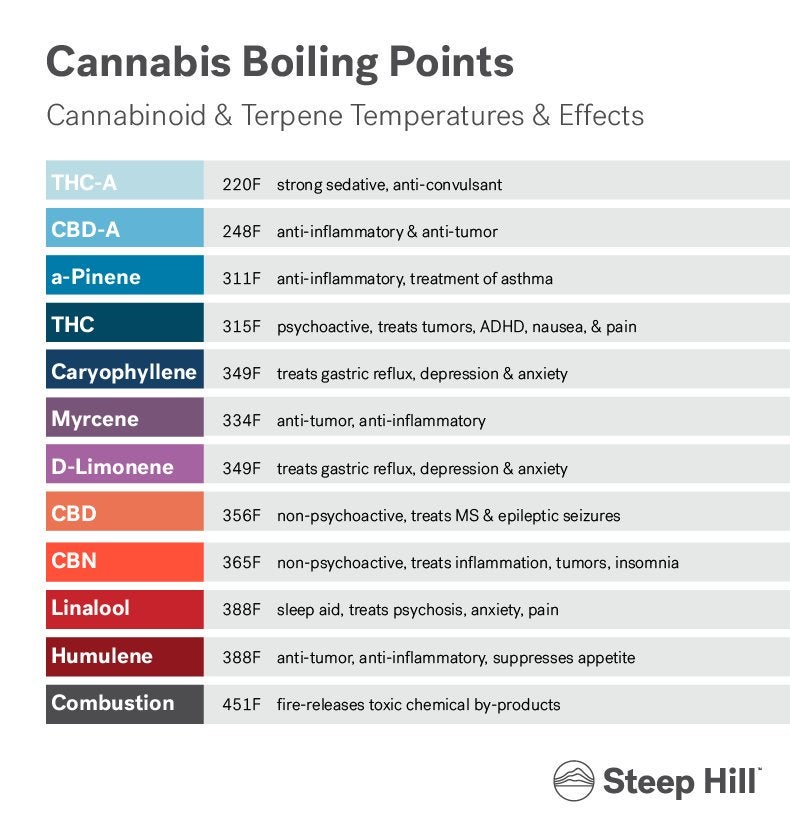The more we learn about cannabis, the more we’re realising that it’s not just THC and CBD that matters; rather, its benefits seems to be achieved through an intricate network of compounds collaborating with one another. And we’re not simply talking about cannabinoids. Terpenes, too, play an integral part in the cannabis experience.
In a nutshell, terpenes are the essential oils that give the cannabis its distinct aromas. These compounds aren’t just unique to the cannabis plant; they’re found everywhere in nature with more than 40,000 structures identified thus far. Terpenes produce the signature fragrances we associate with citrus, pine, spices, berries, etc. In the cannabis plant, there are more than 100 terpenes present with combinations and varieties differing from strain to strain.
What are Terpenes and Terpenoids
You may have come across the term terpenoids. Often, it’s used interchangeably with terpenes; although to avoid any confusion, we should point out that there is a small difference. Terpenes are produced naturally by the plant and consist of carbon and hydrogen atoms. Terpenoids, by contrast, are derived from terpenes once the plant becomes oxygenized during drying. In other words, terpenoids are terpenes with an oxygen atom thrown in. To keep this article simple, we’re using “terpenes” as an umbrella term, covering both states of the compound.
Terpenes in Cannabis
Besides giving the plant its many aromas, terpenes also have psychoactive and pharmacological qualities. Some provide relaxation, others incite focus, many are even known to offer pain and inflammation relief. For the sake of sanity, we won’t detail the 100-plus terpenes in cannabis but instead focus on a few prevalent types (those often advertised by today’s popular products):
Alpha-Pinene
This is the most common terpene in cannabis. As its name suggests, it’s distinguished by a pine-tree aroma. Pinene is a bronchodilator, meaning it opens airways, which makes it a potential candidate for treating asthma. It’s also known to have anti-inflammatory effects. On the psychoactive front, it produces a sense of alertness.
Myrcene
Myrcene may be the reason why skunky weed is so often associated with the couch-lock experience. This terpene, which produces that musky, herbal scent we associate with weed, has sedative qualities. What’s more, its interaction with THC may actually elevate the cannabinoid’s effect and, in turn, your high.
Limonene
As you can probably guess, this terpene has a refreshing, citrusy smell. It’s been known to alleviate heartburn and gastric reflux. It also has antibacterial properties. Considered a mood elevator, Limonene is purported to relieve stress, anxiety, and depression.
Caryophyllene
This peppery terpene is used for pain relief, as an anti-inflammatory, and even to treat insomnia. It’s the one compound on this list without any detectible mood-altering properties.
Linalool
This floral terpene has been linked to serotonin release and is often used as an antidepressant. Studies have demonstrated that the terpene may reduce memory loss and poor concentration that result from sleep deprivation. It also contains anticonvulsant properties.
Humulene
Humulene has that earthy smell we find in hops. This anti-inflammatory terpene has been studied for its potential to combat tumour growth. It’s known to produce a sense of alertness.
Terpenes Chart
Here’s a nifty rundown of these popular terpenes, their effects, and their boiling points:

Source: Steep Hill
The Entourage Effect
Terpenes’ effect on cannabinoids has been seriously understudied. We’re nowhere near fully understanding how these compounds relate to the entourage effect, a phenomenon in which different cannabis compounds interact with one another to perform various functions (i.e. the way in which myrcene elevates the effects of THC).
We do know that terpenes help speed up the absorption of cannabinoids in our bloodstream. We also know that some of them bind with the same receptors in our bodies as cannabinoids, potentially altering the way cannabinoids affect us. For instance, there is evidence suggesting that combining the cannabinoid CBG with linalool and limonene helps treat staph infections. It’s also likely that terpenes with similar properties are, in fact, working with one another to elevate desired antianxiety and pain-relief effects.
With that said, there are so many different terpene-to-terpene and terpene-to-cannabinoid combinations that it’ll be years before we understand all the intricacies.
Terpenes, Concentrates, and Full-spectrum CBD Oil
As more and more studies give credence to the entourage effect, cannabis products are jumping on the full-spectrum bandwagon, favoring a combination of compounds over isolates. For instance, full-spectrum CBD oils (oils that incorporate other compounds to bolster CBD’s benefits) are nowadays experimenting with different terpene profiles to enhance not only aromas but also therapeutic qualities.
Terp sauce is yet another product that’s picking up steam. These dabbing concentrates can contain up to 60% terpenes (along with other cannabinoids). The beauty of concentrate terps is that you get to tweak the flavours and profiles to your liking. Products such as vaporizer and E-nails give you great heat control, allowing you to adjust to different terpene boiling points and personalise the experience.
Other Terpene Benefits
Beyond smoking and dabbing products, cannabis terpenes are being embraced by the health, beauty, and hospitality industry. Topicals and essential oils are now incorporating cannabis terpenes to produce new and exciting olfactory sensations. Marijuana aromatherapy, cannabis-focused massages, CBD facials—weed terpenes are popping up in a slew of treatments.
And even if you’re skeptical of the “health benefits” these products and services are claiming, it’s perfectly fine to just appreciate terpenes for the simple fact that they smell nice. Aromas evoke memories, they bring us back to our childhood or whisk us away to a far-off place. Pleasant smells put us in pleasant moods, plain and simple.
Terpenes play an integral role in the cannabis experience. In the same way wine isn’t just about “getting drunk”, cannabis isn’t just about getting “high.” Next time you’re smoking or vaping or eating cannabis, take a moment to appreciate all the sensations this magical plant provides. In other words, stop and smell the roses (geraniol), or lavender (linalool), or cardamom (myrcene), or whatever other aroma is embedded your bud.
